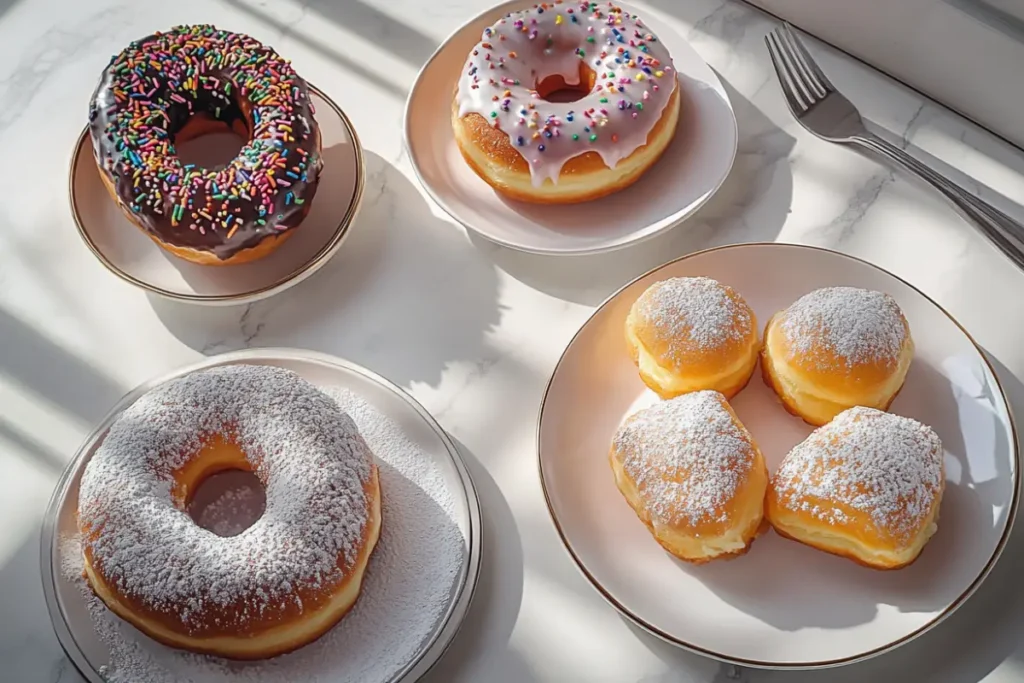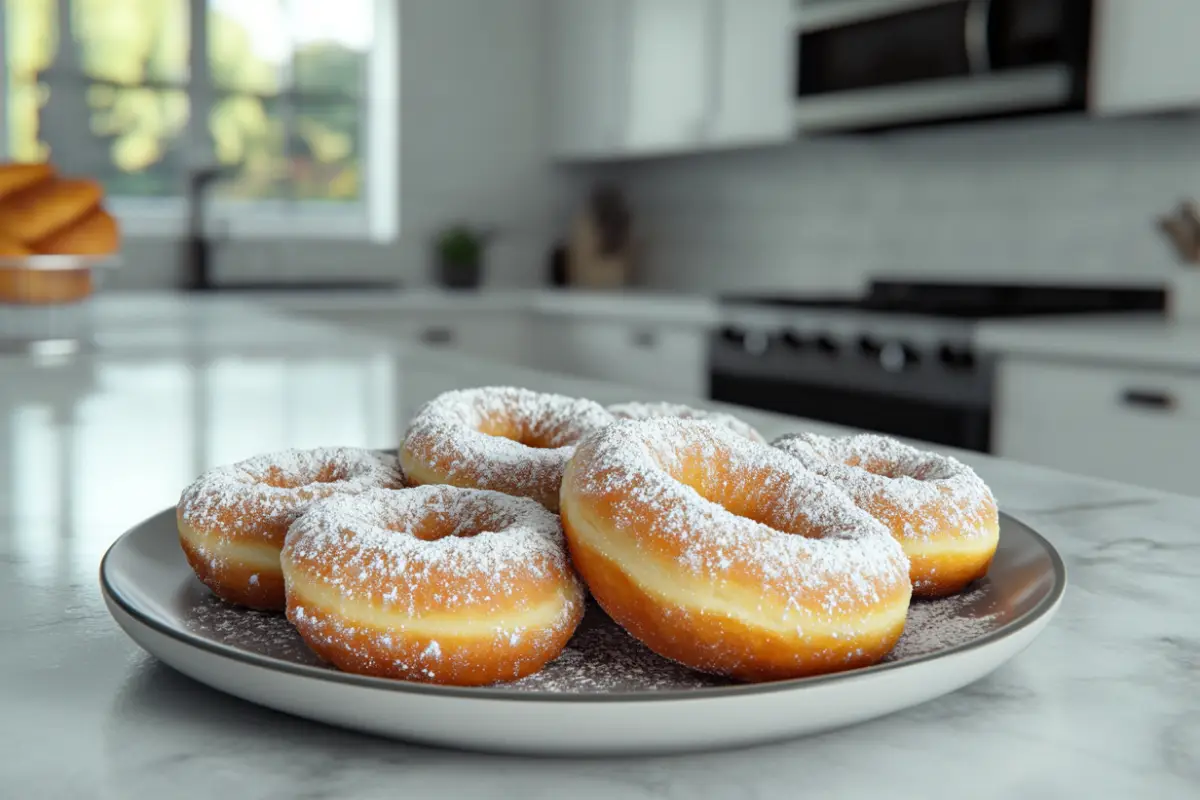Last Updated on March 7, 2025 by Simon
If you’ve ever found yourself at a bakery or café, wondering whether you should go for a donut or a beignet, you’re not alone. These two deep-fried desserts may look similar, but they have distinct differences in texture, flavor, and origin. Whether you’re traveling through the streets of New Orleans or browsing a coffee shop menu, it’s important to know what sets these two treats apart.
While donuts have become an iconic part of American breakfast culture, beignets are deeply rooted in French culinary tradition. Despite their differences, both are irresistibly delicious, making it hard to choose between the two. So, what is the difference between a donut and a beignet? Let’s explore their key distinctions in terms of ingredients, preparation methods, and cultural significance.
By the end of this guide, you’ll not only know the differences between donuts and beignets, but you’ll also understand why each one holds a special place in the world of desserts.
Ready to find out which one best suits your taste buds? Let’s dive in.
Sweet fried pastries like donuts and beignets often confuse people, even though both are crowd favorites. Although both treats come from deep-fried dough, they differ in origin, texture, shape, and toppings. Let’s break down each key difference to give you a complete understanding of what sets a donut apart from a beignet.
Table of contents
1. Origin and Cultural Background
The origins of donuts and beignets are deeply rooted in different culinary traditions.
Donut (or Doughnut) Origins
The modern donut has become synonymous with American culture. However, its origins trace back to European settlers, particularly the Dutch, who brought their version of fried dough called “olykoeks” (meaning “oily cakes”) to the United States. By the early 19th century, these fried dough treats evolved into the ring-shaped or filled donuts we know today.
In the U.S., donuts became popularized by donut shops, especially during the early 20th century. Today, they are seen as a staple breakfast treat often paired with coffee.
Beignet Origins
The beignet, on the other hand, has its roots in French cuisine. The word “beignet” literally translates to “fritter” or “bump” in French. The pastry made its way to New Orleans in the 18th century, brought by French settlers. It quickly became a beloved local treat, particularly at the iconic Café du Monde, which still serves them fresh with powdered sugar.
Beignets tie more deeply to French and Creole culinary traditions and often accompany Mardi Gras celebrations and New Orleans cuisine, unlike donuts.

2. Texture and Dough Differences Between Donut and Beignet
One of the biggest differences between donuts and beignets lies in their texture.
Donuts: Soft and Fluffy
Donuts are typically made with a yeast dough (for classic raised donuts) or cake batter (for cake donuts). The yeast donuts are light and airy, while cake donuts are denser and more crumbly.
Most donuts are slightly chewy, with a soft interior and a thin, sometimes crispy exterior.
Beignets: Light, Airy, and Crispy
Beignets, on the other hand, have a more airy texture. They are made from a choux pastry dough (similar to the dough used for éclairs and cream puffs) or a simple yeast dough. The dough is cut into square or rectangular pieces before being fried.
The result is a pastry that is crisp on the outside and pillowy on the inside. When fresh, beignets are incredibly light and delicate, with hollow pockets inside that make them unique compared to the more solid interior of donuts.
3. Shape and Appearance
The visual differences between donut and beignet are easy to spot.
Donuts: Rings and Filled Shapes
Bakers typically shape donuts into rings with a hole in the middle. However, they also make round or oval donuts, filling them with jam, custard, cream, or other sweet fillings.
The ring shape of a donut is iconic and instantly recognizable, often glazed, sprinkled, or frosted for added flavor.
Beignets: Square or Rectangular
Beignets are generally square or rectangular with no hole. They are usually served plain, dusted heavily with powdered sugar. Unlike donut, beignet aren’t typically frosted, filled, or topped with sprinkles.
Their rustic shape and thick coating of powdered sugar make them stand out as a more traditional French pastry.
4. Toppings and Glazes
When it comes to toppings and glazes, donuts and beignets take very different approaches.

Donuts: A Variety of Toppings
Donuts are known for their versatility in toppings. Some common toppings include:
- Glazes (like vanilla, chocolate, or maple)
- Powdered sugar
- Sprinkles
- Frostings
- Cinnamon sugar
- Crushed nuts
Filled donuts can also include fruit jams, custards, or creams.
Beignets: Powdered Sugar Only
In contrast, beignets are traditionally served plain with a generous dusting of powdered sugar. The focus is on the pastry itself, rather than the toppings. In New Orleans, beignets are often paired with strong coffee (like chicory coffee) for a perfect balance of sweetness and bitterness.
5. Cooking Method (donut vs Beignet)
Both donuts and beignets are deep-fried, but there are slight differences in how they are prepared.
Donuts
Bakers typically fry donuts at a lower temperature to cook them evenly inside and out. After frying, they glaze or coat the donuts with various toppings.
Some donuts, especially cake donuts, also bake in the oven instead of frying, although this method is less traditional.
Beignets
Cooks usually fry beignets at a higher temperature for a shorter time to create their crispy exterior and hollow interior. Serving them fresh and warm keeps their light, airy texture at its best.
6. Flavor Profile
While both pastries are sweet, their flavors differ based on the dough and toppings.
- Donuts have a sweeter, more buttery flavor due to the addition of sugar, milk, and sometimes eggs in the dough.
- Beignets are less sweet on their own but become sweeter with the powdered sugar topping. Their flavor is more subtle and delicate compared to donuts.
Summary of Key Differences
| Feature | Donut | Beignet |
|---|---|---|
| Origin | United States | France (New Orleans) |
| Texture | Soft and fluffy | Light, airy, and crispy |
| Shape | Ring or filled | Square or rectangular |
| Toppings | Variety (glazes, sprinkles) | Powdered sugar |
| Flavor | Sweet, buttery | Subtle, delicate |
| Cooking Method | Lower temperature, longer time | Higher temperature, shorter time |
FAQs
No, beignets are not just French donuts. Both are deep-fried pastries, but they differ in texture, shape, and origin. Beignets are lighter, airier, and square-shaped with powdered sugar, rooted in French and New Orleans cuisine. Donuts are typically ring-shaped or filled, with various toppings, and are a staple of American breakfast culture.
Yes, beignets do taste different from donuts. While beignets are less sweet and rely on powdered sugar, donuts tend to be sweeter due to sugar and milk in the dough. Beignets have a light, airy center with a crispy exterior, whereas donuts are softer and chewier. Additionally, donut flavors vary more thanks to different toppings, glazes, and fillings.
Yes, you can use beignet dough to make donuts, but the outcome will differ. Beignet dough, often made with choux or yeast-based pastry, fries up lighter and puffier. Donut dough, however, is denser and holds its shape better for rings or filled varieties. So, if you swap doughs, expect noticeable differences in both texture and flavor.
Neither beignets nor donuts are healthy, as both are deep-fried and high in calories and carbs. However, beignets usually have fewer toppings, making them slightly lighter if plain, while donuts often have glazes or fillings that add more sugar. This is yet another difference between a donut and a beignet, but both are best enjoyed in moderation.
For authentic beignets, start in New Orleans, especially at Café du Monde, serving them since 1862. You can also find beignet mixes online or visit French bakeries and New Orleans-style restaurants. For the best experience, choose New Orleans-style beignets.
Donut or Beignet – Which Should You Choose?
By now, you can clearly spot the key differences between donuts and beignets, from their origins and shapes to their textures and flavors. Both desserts showcase a rich cultural history and deliver unique experiences to anyone who enjoys them. For example, you might savor a sugary powdered beignet while strolling through New Orleans or bite into a freshly glazed donut at your local bakery. In either case, each treat brings something special. Ultimately, people love both pastries, but for very different reasons.
If you crave something light, airy, and deeply rooted in tradition, you will likely choose a beignet. On the other hand, if you prefer a more versatile treat with endless possibilities for toppings, glazes, and fillings, a donut will suit you better. Your final choice depends on whether you want a simple, classic pastry or a sweet snack with plenty of room for customization. Either way, both options will surely satisfy your sweet tooth.
For those fortunate enough to visit New Orleans, trying fresh beignets from Café du Monde is, without question, a must. Meanwhile, if you’re staying home and need a quick, sweet snack, you can never go wrong with a classic donut. In the end, both are equally delightful indulgences, each worth enjoying in its own way.
In the end, both pastries offer a little bite of indulgence. Why choose one when you can enjoy both?
If learning about beignets has sparked your curiosity, why not try making them yourself? Check out our detailed guide on How to Make Authentic French Jelly Beignets at Home for step-by-step instructions on creating this delicious treat from scratch. Perfect for impressing guests or indulging in a sweet homemade pastry!

